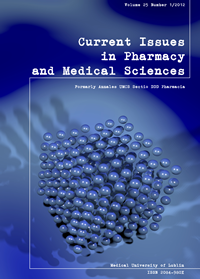“Legal highs” – drugs of the twenty-first century
DOI:
https://doi.org/10.12923/j.2084-980X/25.1/a.20Keywords:
legal highs, BZP, TFMPP, Salviae divinorum, Diviner’s Sage, Kratom tree, Mitragyna speciosaAbstract
"Legal highs" is a term that embraces many compounds, including plant substances and synthetic derivatives. Trends in the use of traditional drugs of abuse by young people, are downward. On the other hand, we can observe an increasing prevalence of "smart drugs" use. These are often sold by online shops offering a wide range of products as alternatives to illegal drugs. However, the degree of risk posed by the use of “legal highs” for individual users, and for public health is unknown and difficult to assess [2,9,18]. The health risk may also increase when people use high doses of these products or mix these with alcohol or other drugs of abuse [18]. These drugs increase the risk of serious interactions and may lead to the poisoning of the body. Moreover, there is no information on their packaging about the active ingredients of the products, their dosages and their potential negative side effects. In addition, considerable variation was noted regarding the amount of information provided by online retailers about the mode of use and the health risks of the products they were selling [9]. What is more, these products fall outside pharmaceutical licensing regulations and control, and consequently their quality is not subject to scrutiny. This paper describes some of the selected substances known as "legal highs". It should be noted that the list of species of psychoactive, hallucinogenic and narcotic species, mainly plants and fungi, used to produce highs in the world, is much greater. Moreover, new psychoactive substances that appear require numerous and thorough research, and it is impossible to immediately determine the short- and long-term effects of the use of these substances. Let us hope that most of these substances will be soon under control and will be on the list of controlled substances.
References
1. Addy P.H.: Acute and post-acute behavioral and psychological effects of salvinorin A in humans. Psychopharmacology, 220, 195, 2012.
2. Antia U. et al.: Validation of an LC–MS method for the detection and quantification of BZP and TFMPP and their hydroxylated metabolites in human plasma and its application to the pharmacokinetic study of TFMPP in humans. J. Forensic. Sci., 55, 1311, 2010.
3. Babu K.M. et al.: Opioid receptors and legal highs: Salvia divinorum and Kratom. Clin. Toxicol., 46, 146, 2008.
4. Butler R.A. and Sheridan J.L.: Highs and lows: patterns of use, positive and negative effects of benzylpiperazine-containing party pills (BZP-party pills) amongst young people in New Zealand. Harm Reduct. J., 4, 2007.
5. Dresen A. et al.: Monitoring of herbal mixtures potentially containing synthetic cannabinoids as psychoactive compounds. J. Mass. Spectrom., 45, 1186, 2010.
6. Fantegrossi W.E. et al.: Reinforcing and discriminative stimulus effects of 1- benzylpiperazine and trifluoromethylphenylpiperazine in rhesus monkeys. Drug Alcohol Depend., 77, 161, 2005.
7. Gibbons S. and Zloh M.: An analysis of the ‘legal high’ mephedrone. Bioorg. Med. Chem. Lett., 20, 4135, 2010.
8. Herndon J.L. et al.: Mechanistic investigation of the stimulus properties of 1-(3-trifluoromethylphenyl)piperazine. Pharmacol. Biochem. Behav., 43, 739, 1992.
9. Hillebrand J. et al.: Legal highs on the Internet. Subst. Use Misuse, 45, 330, 2010.
10. Jan R.K. et al.: Determining the subjective effects of TFMPP in human males. Psychopharmacology, 211, 347, 2010.
11. Johnson M.W. et al.: Human psychopharmacology and dose-effects of salvinorin A, a kappa opioid agonist hallucinogen present in the plant Salvia divinorum. Drug Alcohol Depend., 115, 150, 2011.
12. Kapp F.G. et al.: Intrahepatic cholestasis following abuse of powdered kratom (Mitragyna speciosa). J. Med. Toxicol., 7, 227, 2011.
13. Martin M. et al.: Evidence of mephedrone chronic abuse through hair analysis using GC/MS. Forensic Sci. Int., 29, 2011.
14. Prisinzano T.E.: Psychopharmacology of the hallucinogenic sage Salvia divinorum. Life Sci., 78, 527, 2005.
15. Schep L.J. et al.: The clinical toxicology of the designer ‘‘party pills’’ benzylpiperazine and trifluoromethylphenylpiperazine. Clin. Toxicol., 49, 131, 2011.
16. Vardakou I. et al.: Drugs for youth via Internet and the example of mephedrone. Toxicol. Lett., 201, 191, 2011.
17. Vardakou I. et al.: Spice drugs as a new trend: mode of action, identification and legislation. Toxicol. Lett., 197, 157, 2010.
18. Winstock A.R. & J.D. Ramsey: Legal highs and the challenges for policy makers. Addiction, 105, 1685, 2010.
19. Zuba D. et al.: Comparison of “herbal highs” composition. Anal. Bioanal. Chem., 400, 119, 2011.
Downloads
Published
Issue
Section
License
Copyright (c) 2012 Authors

This work is licensed under a Creative Commons Attribution-NonCommercial-NoDerivatives 3.0 Unported License.


